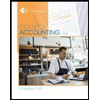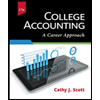
1.
Introduction:
Step-down method: The overhead costs of supporting incurred by the supporting department are allocated to other supporting departments and also the operating department based on the allocation base.
Allocation of the service department’s cost to the consuming department and the predetermined overhead rates in the operating department.
2.
Introduction:
Direct method: Under the direct method, the overhead costs incurred by the supporting department are directly allocated to the operating department.
Allocation of the service department’s cost to the consuming department using the direct method and the predetermined overhead rate.
3.
a.
Step-down method: The overhead costs of supporting incurred by the supporting department are allocated to other supporting departments and also the operating department based on the allocation base.
The amount of overhead cost for the job using overhead rates computed in parts 1 and 2.
3.
b.
Step-down method: The overhead costs of supporting incurred by the supporting department are allocated to other supporting departments and also the operating department based on the allocation base.
The reason the step-down method is a better base for computing the predetermined rates than the direct method.
Want to see the full answer?
Check out a sample textbook solution
Chapter 4 Solutions
FUNDAMENTAL ACCOUNTING PRINCIPLES
- Can you help me solve this general accounting question using the correct accounting procedures?arrow_forwardPlease provide the solution to this general accounting question with accurate accounting calculations.arrow_forwardI need the correct answer to this general accounting problem using the standard accounting approach.arrow_forward
- You are employed by an external audit firm that is hired by JBltd, a privately owned incorporated business. Accounting records are maintained on a computer using proprietary software. You have worked on the audit for three years and this year you are in charge of the audit. Your assistant is a newly recruited business graduate who has done an accounting course but has no practical experience. Because of the small size of the company there is limited opportunity for segregation of duties. You decide, as in previous years, that the appropriate audit strategy is to obtain evidence primarily through the performance of substantive procedures. You also plan to perform the audit around the computer as the proprietary software is known to be reliable and details of all transactions and balances can be readily printed out. On arriving at the company's premises in December 2019 to perform the final audit on the 31 October 2019 financial statements, you obtain a copy of the year end bank…arrow_forwardGeneral accountingarrow_forwardI needarrow_forward
 Financial AccountingAccountingISBN:9781305088436Author:Carl Warren, Jim Reeve, Jonathan DuchacPublisher:Cengage LearningPrinciples of Accounting Volume 1AccountingISBN:9781947172685Author:OpenStaxPublisher:OpenStax College
Financial AccountingAccountingISBN:9781305088436Author:Carl Warren, Jim Reeve, Jonathan DuchacPublisher:Cengage LearningPrinciples of Accounting Volume 1AccountingISBN:9781947172685Author:OpenStaxPublisher:OpenStax College College Accounting, Chapters 1-27 (New in Account...AccountingISBN:9781305666160Author:James A. Heintz, Robert W. ParryPublisher:Cengage Learning
College Accounting, Chapters 1-27 (New in Account...AccountingISBN:9781305666160Author:James A. Heintz, Robert W. ParryPublisher:Cengage Learning College Accounting (Book Only): A Career ApproachAccountingISBN:9781337280570Author:Scott, Cathy J.Publisher:South-Western College Pub
College Accounting (Book Only): A Career ApproachAccountingISBN:9781337280570Author:Scott, Cathy J.Publisher:South-Western College Pub College Accounting, Chapters 1-27AccountingISBN:9781337794756Author:HEINTZ, James A.Publisher:Cengage Learning,
College Accounting, Chapters 1-27AccountingISBN:9781337794756Author:HEINTZ, James A.Publisher:Cengage Learning, Intermediate Accounting: Reporting And AnalysisAccountingISBN:9781337788281Author:James M. Wahlen, Jefferson P. Jones, Donald PagachPublisher:Cengage Learning
Intermediate Accounting: Reporting And AnalysisAccountingISBN:9781337788281Author:James M. Wahlen, Jefferson P. Jones, Donald PagachPublisher:Cengage Learning





